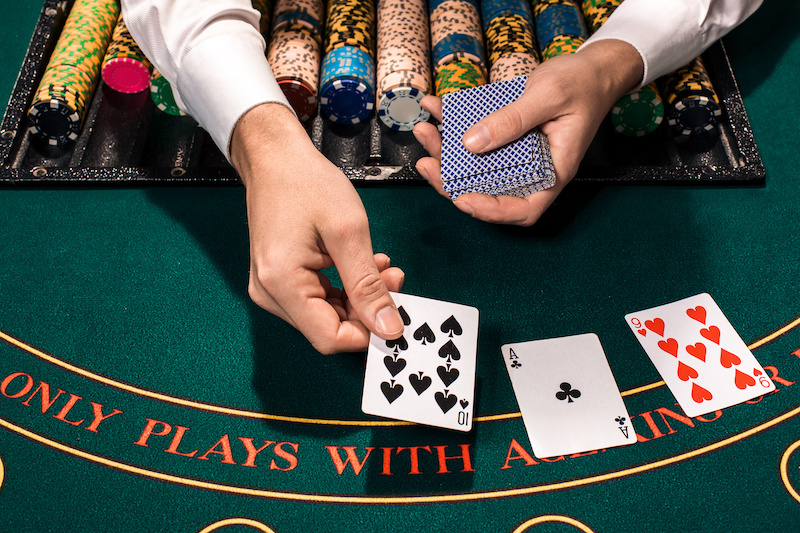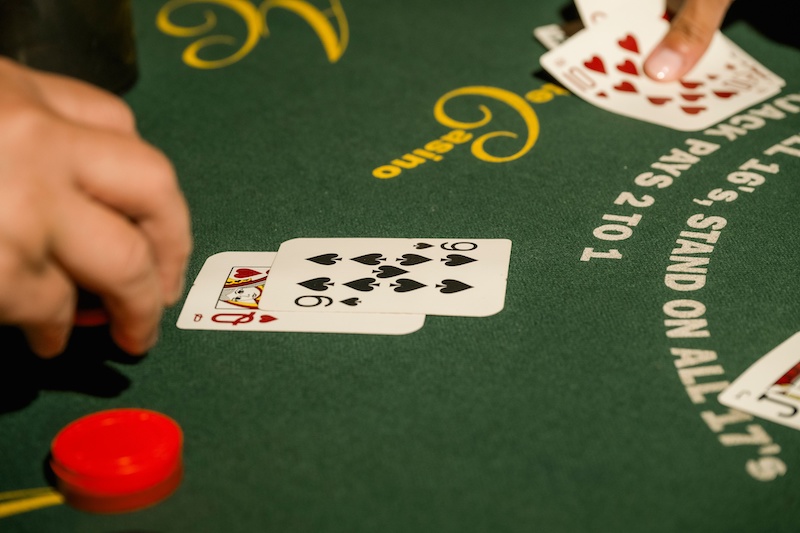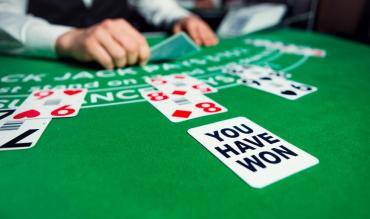This guide covers the best blackjack strategies—from beginner tips to advanced plays—so you can reduce the house edge and make mathematically correct decisions at the table.
If you’re searching for how to win at blackjack, the real advantage comes from consistently applying basic strategy, not relying on luck. You’ll also learn how to use a blackjack strategy chart and avoid common mistakes that cost players money over time.
Key Takeaways for Blackjack Strategy
- Use a basic strategy chart for every hand—perfect play keeps the house edge under 1% in many rulesets.
- Avoid 6:5 blackjack payouts; they add ~1.4–1.5% to the house edge compared with the standard 3:2 payoff.
- Split Aces and 8s, skip insurance, and master the core double‑down and surrender spots to protect your bankroll.
- Know the table rules (S17 vs H17, DAS vs NDAS). Small rule changes can shift the correct play.
- Beginners: focus on one thing—follow the chart consistently. Consistency beats “gut feel” over the long run.
Note: Unless stated otherwise, these blackjack tips apply to most games and assume recreational play (not card counting). Always check the table rules first.
If this article interests you, keep reading. Alternatively, explore other topics like blackjack side bets and roulette strategy.
Blackjack Basics: Key Rules and Abbreviations (S17, H17, DAS, NDAS)
• S17 = Dealer stands on soft 17
• H17 = Dealer hits soft 17
• DAS = Doubling down after splitting pairs allowed
• NDAS = Doubling down after splitting pairs not allowed
Top Blackjack Strategies to Win More (15 Tips)
Blackjack strategy #1: Always double down on hard 11
Hard 11 is one of the best double‑down spots. In most games, doubling down against any dealer upcard outperforms hitting. The only exception is multi‑deck S17 versus a dealer Ace, where hitting is marginally better.
Blackjack strategy #2: Always split 8s and Aces
Always split 8s and Aces, regardless of the dealer’s upcard. Splitting 8s turns a weak 16 into two hands with better potential. Splitting Aces gives you two high‑upside starting hands. Note: In H17 multi‑deck or H17 double‑deck NDAS, surrender 8‑8 vs Ace if offered.
Blackjack strategy #3: Never split 5s or 10s
Never split 5s or 10s. Treat 5‑5 as a hard 10 (a prime doubling hand), and keep 10‑10 together because 20 is already one of the best totals in blackjack.
Blackjack strategy #3: Never split 5s or 10s
Never split 5s or 10s. Play 5‑5 as a hard 10 (a prime doubling hand) and keep 10‑10 together since 20 is already one of the best totals in blackjack.
Blackjack strategy #5: Hit soft 18 vs dealer 9, 10, or Ace
Against a dealer 9, 10, or Ace, soft 18 (A‑7) isn’t strong enough to stand. Hitting improves your chances of reaching 19–21 without busting. Exception: in single‑deck S17 versus a dealer Ace, standing is marginally better.

Blackjack strategy #6: Double 10 vs dealer 9 or less
With a two‑card 10, double down when the dealer shows 2 through 9. You’re the favorite, and doubling wins more often than hitting over the long run.
Blackjack strategy #7: Key adjustments for H17 tables
In H17 games (dealer hits soft 17), make these double‑down adjustments: hard 11 vs Ace, soft 19 (A‑8) vs 6, and soft 18 (A‑7) vs 2. These are minor changes, but they add up over thousands of hands.
Blackjack strategy #8: Double soft 13–18 vs dealer 5 or 6
Double A‑2 through A‑7 (soft 13–18) when the dealer shows 5 or 6. These dealer upcards are “bust cards,” so increase your bet when holding a flexible soft hand.
Blackjack strategy #9: Stand on 9‑9 vs dealer 7
With 9‑9 against a dealer 7, stand—don’t split. Holding 18 performs marginally better than breaking it into two hands against a likely dealer 17.
Blackjack strategy #10: Surrender the toughest hands when offered
If surrender is available, give up hard 16 vs 9, 10, or Ace—and hard 15 vs 10. This saves half your bet in the worst spots and reduces long‑term losses.
Blackjack strategy #11: Single‑deck—double 8 vs dealer 5 or 6
In single‑deck blackjack, double an 8 against a dealer 5 or 6. The single‑deck card mix shifts the math so doubling outperforms hitting in this spot.
Blackjack strategy #12: Split 2s/3s vs dealer 2–3 when DAS is allowed
With 2‑2 or 3‑3 against a dealer 2 or 3: split if DAS is allowed; otherwise hit. Exception: in single‑deck, split 2‑2 vs a dealer 3 even if doubling after split isn’t permitted.
Blackjack strategy #13: Never take insurance (or ‘even money’)
Never take insurance. The 2‑to‑1 payout is worse than the true odds of the dealer having blackjack, making it a negative‑EV side bet. “Even money” on your blackjack against a dealer Ace is simply insurance in disguise.
Blackjack strategy #14: Multi‑card 16 vs dealer 10—consider standing
Basic strategy says to hit hard 16 vs a dealer 10 (if surrender isn’t offered). A small accuracy tweak: if your 16 is a multi‑card total (e.g., 7‑5‑4), standing performs marginally better than hitting.
Blackjack strategy #15: Avoid 6:5 blackjack payouts
Avoid 6:5 blackjack tables. Switching the payout from 3:2 to 6:5 adds about 1.4–1.5 percentage points to the house edge, and in many multi‑deck games the total edge can exceed 2%.

Common Mistakes to Avoid in Blackjack
- Playing 6:5 blackjack tables (the payout cut costs more than most players realize).
- Taking insurance or “even money” against a dealer Ace.
- Standing on soft 18 (A‑7) vs a dealer 9, 10, or Ace instead of hitting.
- Ignoring table rules like S17 vs H17 and DAS vs NDAS (strategy shifts with rules).
- Chasing losses with betting systems instead of focusing on correct plays and bankroll discipline.
- Trusting “gut feel” when a strategy chart gives the mathematically best play.
Blackjack Strategy Chart Explained
A blackjack strategy chart shows the optimal play for every hand based on your cards and the dealer’s upcard. It’s the fastest way for beginners to play correctly and avoid costly mistakes.
- Find your hand on the left (hard total, soft total, or pair).
- Find the dealer’s upcard across the top.
- Follow the symbol at the intersection: Hit, Stand, Double, Split, or Surrender (if available).
Example Plays from the Strategy Chart
- 6‑6 vs dealer 4 — Split (P): Splitting 6‑6 gives you two hands starting at 6, both with strong potential against a weak dealer 4.
- 15 (10‑5) vs dealer 6 — Stand (S): Standing on 15 is correct because the dealer’s 6 is a bust card; hitting risks breaking a hand that already has favorable odds.
- A‑7 (soft 18) vs dealer 9 — Hit (H): Hitting improves your chances against a strong dealer upcard; standing leaves you too weak.
- 10 vs dealer 9 — Double (D): Doubling on 10 is powerful because you’re favored to draw a strong card against a vulnerable dealer.
- 16 vs dealer Ace — Surrender (R): If surrender is offered, giving up half your bet here saves money in one of the worst spots.
Use a Strategy Chart Matched to Your Rules
A blackjack strategy chart is only accurate if it matches the rules of your game. Key variations to check before you play include:
- Number of decks (single‑deck vs multi‑deck): Fewer cards shift probabilities and change some plays.
- Dealer on soft 17 (S17 vs H17): Whether the dealer hits or stands alters doubling and standing decisions.
- Doubling after split (DAS vs NDAS): Impacts pair‑splitting strategy and overall EV.
- Surrender availability: Changes how you handle tough hands like 15 or 16 vs high dealer cards.
Using the wrong chart leads to systematic mistakes. Always confirm the rules first, then follow the chart consistently.
Multi‑Deck Blackjack Strategy Chart (4+ decks, S17, NDAS)
House Edge Comparison (With vs Without Strategy)
| Scenario | Typical impact on the house edge |
| Follow a blackjack strategy chart (basic strategy). | Often under 1% in many common rulesets (lower with favorable rules). |
| Play by feel / make frequent basic mistakes. | Can easily climb above 2% over time. |
| Play 6:5 blackjack instead of 3:2. | Adds ~1.4–1.5 percentage points to the house edge. |
| Take insurance regularly. | Further increases long‑term losses (negative‑EV side bet). |
Use One (or a Mix) of These Methods to Learn Basic Blackjack Strategy Faster
Here are four ways to memorize the best playing strategy when playing at a casino:
- Flashcards: Drill the most common hands (soft totals, 12–16 vs strong upcards, and split rules) until the correct play is automatic.
- Blank Strategy Chart: Draw a blank strategy chart and fill it in from memory. For repeated plays, such as hard 17, write the strategy once with a line across the row to save time.
- Card Practice: Deal yourself two cards and a dealer’s upcard, decide how to play, and check your answer against a strategy chart.
- Blackjack Software: Use apps or online tools to practice making the correct decisions. These programs provide immediate feedback on mistakes.
Blackjack Strategy FAQs
What is the best blackjack strategy for beginners?
Use a basic strategy chart matched to your table rules. It’s the fastest way to improve your odds and reduce the house edge without guessing.
Should I split 8s and Aces every time?
Yes. Always split 8s and Aces in standard basic strategy. It’s one of the biggest long-term EV gains for recreational players.
Can I use a blackjack strategy chart at the table?
Yes—especially online. In live casinos, discreet pocket charts are usually allowed, but always follow venue rules.
Should I ever take insurance in blackjack?
Almost never. Insurance is a negative-EV side bet unless you’re counting cards and know the deck is rich in 10s.
How long does it take to learn basic strategy?
With daily practice (flashcards or a trainer), most players can learn the core decisions in a couple of weeks and keep improving from there.
Does basic strategy guarantee I’ll win?
No. Blackjack has short-term variance, but correct strategy reduces long-term losses and helps you make the mathematically best decision each hand
** Originally published on August 15, 2018
** Article updated on January 20, 2025
